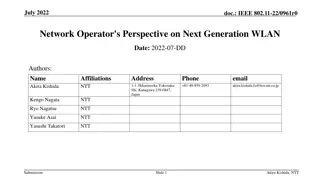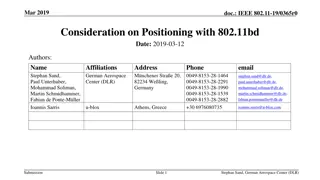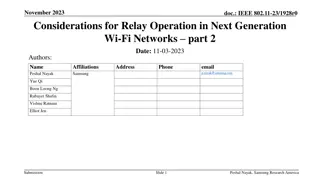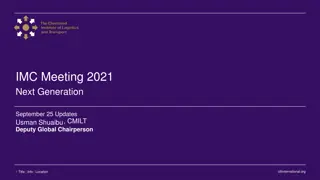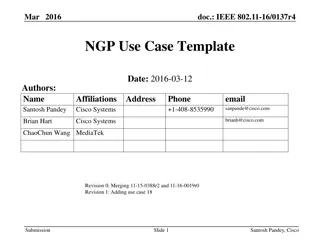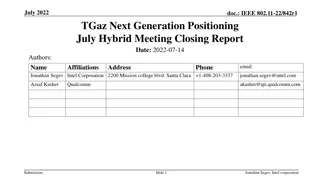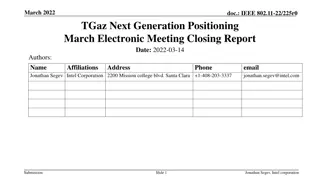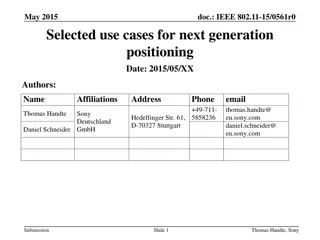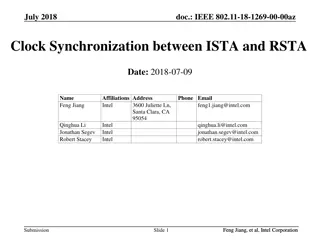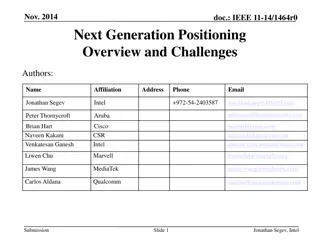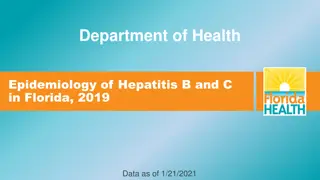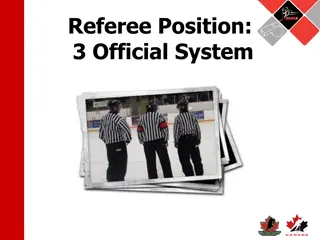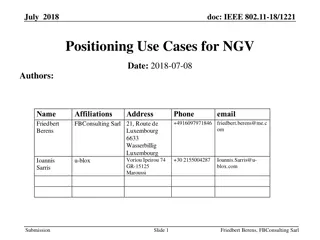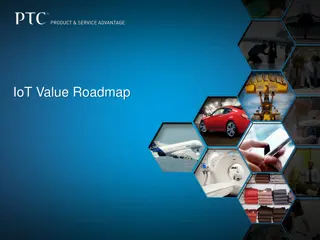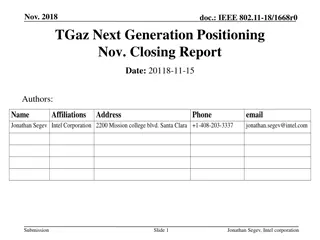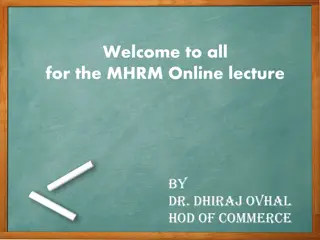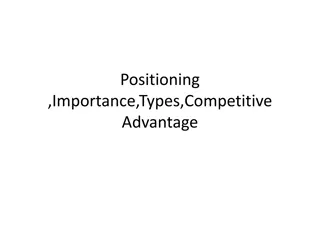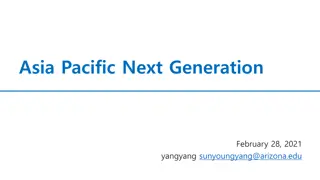
Next Generation Positioning Use Cases in September 2015
Explore use cases for next generation positioning in September 2015, including applications in medical monitoring, indoor geotagging, and video camera positioning. Detailed positioning requirements and scenarios are presented with a focus on accuracy, latency, refresh rate, and user impact within an 802.11 environment.
Download Presentation

Please find below an Image/Link to download the presentation.
The content on the website is provided AS IS for your information and personal use only. It may not be sold, licensed, or shared on other websites without obtaining consent from the author. If you encounter any issues during the download, it is possible that the publisher has removed the file from their server.
You are allowed to download the files provided on this website for personal or commercial use, subject to the condition that they are used lawfully. All files are the property of their respective owners.
The content on the website is provided AS IS for your information and personal use only. It may not be sold, licensed, or shared on other websites without obtaining consent from the author.
E N D
Presentation Transcript
September 2015 Further Use Cases for Next Generation Positioning Date: 2015/09/13 doc.: IEEE 802.11-15/1061r1 Authors: Name Affiliations Address Phone +49-711- 5858236 email thomas.handte@ eu.sony.com daniel.schneider@ eu.sony.com kare.agardh@ sonymobile.com Thomas Handte Sony Deutschland GmbH Hedelfinger Str. 61, D-70327 Stuttgart, Germany Daniel Schneider +46-70- 5513618 K re Agardh Sony Mobile Lund, Sweden Submission Slide 1 Kare Agardh, Sony
September 2015 doc.: IEEE 802.11-15/1061r1 Abstract This document provides several use cases for next generation positioning (NGP/.11az) The use cases are supported with estimates on required accuracy latency refresh rate number of simultaneous users (within AP coverage) The terminology is as 11-15/0388r0 defined in document Submission Slide 2 Kare Agardh, Sony
September 2015 doc.: IEEE 802.11-15/1061r1 1. Positioning for Medical Applications User: Patient under medical surveillance in a hospital or care home. Environment: Building with 802.11 coverage. The expected AP environment is 1 AP per < 25 users or < 100m / 1000 sq. ft. APs support .11ac, .11ax, and .11az Use case: 1. Patient is connected to a portable medical device with WLAN interface (e.g. heart rate monitor) which continuously monitors medical parameters. 2. When the patient moves around, his/her position is tracked and recorded. 3. If monitored medical parameters get severe, a nurse or a doctor is informed including the patient s position for first aid assistance. 4. The medical parameters can be linked with an activity profile which is retrieved from the tracked data. 5. If the patient leaves a certain area, a nurse gets informed (fencing feature). Positioning requirements: Horizontal accuracy: < 1m @ 90% Vertical accuracy: same floor @ 99.9% Latency: < 200ms Refresh rate: 1 locations/s Expected number of simultaneous users: < 40 (within AP coverage area) Impact on Network Bandwidth: low, the impact should be independent on the number of users Submission Slide 3 Kare Agardh, Sony
September 2015 doc.: IEEE 802.11-15/1061r1 2. Indoor Geotagging User: Person with digital camera, smart phone, tablet, or smart eyeglasses Environment: Building (e.g. museum, exhibits, fair, restaurant) with 802.11 coverage. The expected AP environment is 1 AP per < 25 users or < 100m / 1000 sq. ft. (large buildings) 1 AP per floor, optional: multiple APs from neighboring apartments (small buildings) APs support .11ac, .11ax, and .11az Use case: 1. Person takes a picture with a digital camera. 2. Digital camera estimates its position using .11az and tags the picture with its geolocation (like GPS geotagging for outdoor applications) Positioning requirements: Horizontal accuracy: < 1m @ 90% Vertical accuracy: < 1m @ 90% Latency: < 400ms Refresh rate: < 1 locations/s Expected number of simultaneous users: < 10 (within AP coverage area) Impact on Network Bandwidth: low Submission Slide 4 Kare Agardh, Sony
September 2015 doc.: IEEE 802.11-15/1061r1 3. Positioning for Video Cameras User: Enterprise (e.g. shop) installing video surveillance cameras with WLAN connection capability WLAN is used for video transmission, camera control, and positioning of the camera Environment: Building with 802.11 infrastructure. The expected AP environment is 1 AP per < 10 cameras or < 100m / 1000 sq. ft. In some environments P2P is applied APs and STAs support .11ac, .11ax and .11az Use case: 1. A technician installs the surveillance cameras at arbitrary positions. 2. After the setup is done, each camera is triggered to determine its position. 3. The absolute (infrastructure) or relative (P2P) position is fed back to the control room, where the position of all cameras is denoted on a map of the building. 4. The camera position is crucial for a continuous tracking of moving persons (picture handover between cameras). Positioning requirements: Horizontal / Vertical accuracy: both < 1m @ 90% (infrastructure) Distance / Angular accuracy: < 1m @ 90% / < 2 @ 90% (P2P) Latency: < 1s Refresh rate: < 1 locations/day Impact on Network Bandwidth: as low as possible, video dominates Submission Slide 5 Kare Agardh, Sony
September 2015 doc.: IEEE 802.11-15/1061r1 References Cisco Systems Inc., 11-15-0388-00-0ngp NGP Use Case Template Jonathan Segev, Intel, 11-14-1464-02-0wng NG Positioning Overview and Challenges Thomas Handte, Sony, 11-15-0834-00-0ngp-Further- Use-Cases-for-Next-Generation-Positioning Submission Slide 6 Kare Agardh, Sony
September 2015 doc.: IEEE 802.11-15/1061r1 BACKUP Submission Slide 7 Kare Agardh, Sony
September 2015 doc.: IEEE 802.11-15/1061r1 Terminology of doc. 11-15/0388r0 User The end entity (human) who would use this technology Use case A use case is task oriented. It describes the specific step by step actions performed by a user or device. One use case example is a user starting and stopping a video stream. Environment The type of place in which a network is deployed, such as home, outdoor, hot spot, enterprise, metropolitan area, etc. Frequency bands of interest (FBoI): The 802.11 operating frequency bands relevant to this use case. Eg. for a shopping mall s enterprise wireless it will be 2.4GHz and 5GHz AP density: Density of AP deployment, e.g. APs deployed every 4000 sq.ft. AP height: Height, above the floor, at which the APs are deployed, e.g. for shopping mall APs deployed approximately 15-25 ft above the floor Key Location Requirement- Expected Horizontal Accuracy: XY accuracy expected for the use case to succeed, <1m@90% is a requirement is that the computed location be within 1m horizontally of the actual location 90% of the time Expected Vertical Accuracy: Z accuracy expected for the use case to succeed, same floor@99% is a requirement is that the computed location be on the same floor as the actual location 99% of the time. 0.5m@90% is a requirement is that the computed location be within 0.5m vertically of the actual location 90% of the time Expected Latency: Expected time taken to complete a single atomic location process. The location process begins with initiating a location request, then computing location, and ends with returning the computed location. E.g. 10 ms latency would indicate that it takes 10 ms after the request is transmitted to gather measurements, compute a location, and transfer any parameters such that the requester has a location within 10 ms. Expected Refresh Rate: This defines how frequently is the computation expected when client moving. E.g. a refresh rate of 10 locations per second would indicate that location needs to be refreshed 10 times in a second Expected number of simultaneous users TBD, Sony Submission Slide 8
September 2015 doc.: IEEE 802.11-15/1061r1 Straw Poll #1 We support the addition of use case depicted by slide 3 in this submission 11-15/1061r0 to the use case working draft document. Use case 1. Positioning for Medical Applications Y: 21/N:0/A:3 Submission Slide 9 Kare Agardh, Sony
September 2015 doc.: IEEE 802.11-15/1061r1 Straw Poll #2 We support the addition of use case depicted by slide 4 in this submission 11- 15/1061r0 to the use case working draft document. Use case 2. Indoor Geotagging Y:19/N:0/A:1 Submission Slide 10 Kare Agardh, Sony
September 2015 doc.: IEEE 802.11-15/1061r1 Straw Poll #3 We support the addition of use case depicted by slide 5 in this submission 11- 15/1061r0 to the use case working draft document. Use case 3. Positioning for Video Cameras Y:17/N:0/A:7 Submission Slide 11 Kare Agardh, Sony
July 2015 doc.: IEEE 802.11-15/1061r1 Motion on submission 1061/r0 Motion To instruct the use case document editor to add use cases depicted by slides 3,4,5 of submission 11-15/1061r0 to the use case working draft document. Move: K re Agardh 2nd: Edward Au Y: 15 N: 0 A: 2 Submission Slide 12 Jonathan Segev (Intel)


